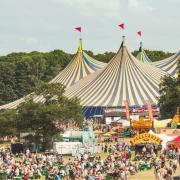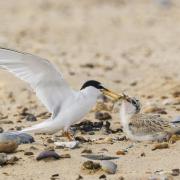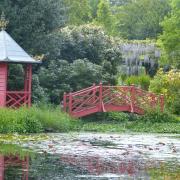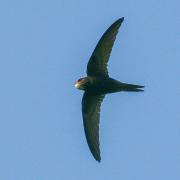'An Eagle for an Emperor, a Gyrfalcon for a King; a Peregrine for a Prince, a Saker for a Knight, a Merlin for a Lady; a Goshawk for a Yeoman, a Sparrowhawk for a Priest,' reads a 15th century manuscript on falconry.
The work illustrates the centuries-long bond and fascination we have with birds of prey. Sadly, this relationship offered no protection to raptors from the 18th century, when large tracts of land throughout the country were dedicated to grazing livestock. Any bird with a hooked beak and sharp talons was now considered a threat to farm animals and game birds. Unrestricted shooting, trapping and poisoning sent their populations into free fall.

According to Steve Piotrowski, of Suffolk Bird Group, and author of The Birds of Suffolk, many birds of prey that were once a familiar sight in Suffolk became extinct as a breeding species. These losses included Marsh Harrier, Honey Buzzard, Common Buzzard and Peregrine Falcon. Other raptor populations were severely depleted, he says.
During the 1950s and 1960s, he says, birds of prey were dealt a further blow when DDT poisoning became prevalent. This powerful chemical, used in agriculture to control insect-borne diseases, proved deadly when it accumulated in the food chain. When digested by raptors it had the effect of thinning egg shell and the loss of clutches. As the environmental damage caused by these toxins became clear, they were phased out.
Thankfully, with strict legal protection, some of Suffolk’s birds of prey are staging a dramatic comeback. Species like Osprey and Honey Buzzard are still rare seasonal visitors to the county and a sighting of a Goshawk or Hen Harrier is still something to cherish, but there are five species that are now comparatively easy to see year-round in Suffolk.

The Common Buzzard, far from common in the county until turn of the century, has undergone the most dramatic revival of all our raptors. It’s unusual these days to go for a long walk in the countryside and not spot at least one of these large raptors soaring overhead. I have observed several of them joining flocks of gulls behind a tractor and plough, searching for any bounty that might be exposed. Recently I’ve even seen one perched on the top of a streetlight on a busy roundabout in Felixstowe.
Rabbits have traditionally formed a large portion of the buzzard’s diet, but it is their catholic tastes that have fuelled their population growth. Rodents, reptiles, birds, invertebrates and carrion all feature on their menu. A buzzard perched on top of a telegraph pole staring intently to the ground is just as likely to dive down onto roadkill as to swoop on a live rabbit.

Also spreading east, but currently in much smaller numbers than buzzards, are Red Kites, Suffolk’s largest resident raptor. Most often seen wheeling high above the tree line, they can be distinguished from buzzards by their more angular wings and forked tail. By the close of the 19th century they were extinct as a breeding bird in England, but successful reintroductions to the south during the 1990s created stable populations that have rapidly expanded their range.
More of a scavenger than a hunter these beautifully marked birds supplement their carrion feeding with a range of invertebrates and occasionally larger prey, such as small mammals and fledglings.

Kestrels remained a familiar sight in the county even as other raptor populations plummeted in the 1970s and 1980s, partly through their habit of hunting over road verges. Most people recognise the distinctive, low-level hovering of this small falcon as it scans the vegetation for prey. Recently, as local authorities have adopted a more nature-friendly attitude to urban green spaces, kestrels have taken advantage of 'no-mow' areas and can frequently be seen hunting in urban parks, scanning the vegetation for their favoured prey, small rodents.
However, research by the British Trust for Ornithology shows recent population declines as the average number of fledgings per nest is considerably fewer. Another obstacle to kestrel expansion could be a lack of suitable nesting sites, although they will use man-made nest boxes which may help alleviate this problem.

As recently as 1971 there was only a single successful Marsh Harrier nest in the whole of the UK. The site of that lone nest was RSPB Minsmere on the Suffolk coast. But from this watershed moment the species’ fortunes have improved dramatically in the ensuing five decades.
From the sanctuary of their Suffolk base, they have recolonised many suitable marshland habitats. The UK population now stands at more than 500 breeding pairs; East Anglia remains a stronghold for the species. This is a specialised raptor, as the name suggests, requiring reedbeds or other dense wetland vegetation in which to nest. These impressive harriers can easily be seen in many of our marshland nature reserves, quartering over the reedbeds in search of rodents, water birds and amphibians.

Although not uncommon, sparrowhawks are adept at keeping out of sight until they are ready to launch a sudden ambush attack on an unsuspecting bird. Therefore, most sightings of these aerial assassins are at garden bird tables or feeders, when they silently swoop in to claim a victim. Sometimes the only evidence that one of these hawks has been active in your neighbourhood will be a pile of plucked feathers and a pair of wings removed from their prey with surgical precision.

Male sparrowhawks are quite small raptors, perfectly adapted to take songbirds and other species up to the size of a thrush. As with most birds of prey, the female is significantly larger than the male, a characteristic known as sexual dimorphism. This makes her a far more formidable hunter, quite capable of taking prey up to the size of jackdaws and gulls.
Illegal persecution of birds of prey undoubtedly persists, and habitat loss and climate change will continue to affect populations, but we can be more optimistic for the future of Suffolk’s raptors than at the turn of the century.
Note: Photo of nesting sparrowhawk taken under a permit.



























